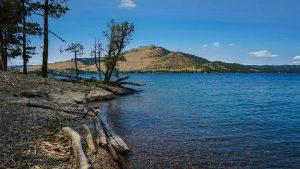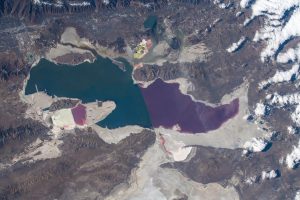Posted on October 11, 2023 by Thomas Sansonetti
The old saying goes “water in the East is for drinking and water in the West is for fighting over!” As a decade of drought conditions continue in the West, litigation has increased over the reduced supply of water. Most of this litigation centers on the availability of water supplies from rivers and their tributaries. Foremost among these waterbodies is the Colorado River which supplies essential water to seven western states.
Now the battle over available water resources is expanding to include lakes—both natural and man-made. Natural lakes occur largely through the creation of geographic depressions in the earth from receding glaciers. Once formed, they depend on current moisture cycles to remain at full lake levels.
On the other hand, man-made lakes are created by the construction of dams built across rivers and/or their tributaries. The Department of the Interior’s Bureau of Reclamation (BOR), created by Congress in 1902, is largely responsible for the construction of dams and water diversions across the West. The mission of the BOR is to manage, develop and protect water and related resources in an environmentally and economically sound manner in the interest of the American public. The BOR’s mandate covers seventeen western states, starting with North and South Dakota plus Nebraska, and ending with three states on the West Coast.
The other key federal agency involved with water use responsibilities is the Federal Energy Regulatory Commission (FERC). In 1979, FERC succeeded the Federal Power Commission established by Congress in 1920. FERC’s regulatory authority includes development of hydropower from dam projects. FERC issues licenses to hydropower operators detailing how and when electricity production may occur.
The management of natural lakes is controlled by state agencies acting pursuant to state law. Some states have statutorily created the position of a State Water Engineer, who manages the list of approved water users and the relative seniority of those rights. Some states have created Water Courts to adjudicate water use within the state’s boundaries. Other states grant the authority to control the use of water to a state agency like a natural resource department. Regardless of which state entity renders decisions on competing water uses, unhappy water claimants can access the judicial branch in contested cases, ultimately leading to a state Supreme Court decision.
On the other hand, the management of a man-made lake is controlled by the entity owning the facility and the water contained within it. If a dam is built with a state-funded appropriation, the lake behind the dam will be managed according to the state law that created the dam’s construction. Similarly, if a dam is built with a Congressionally funded appropriation, the lake behind the dam will be managed according to the applicable federal law, including the dictates of any FERC-issued license associated with the power production component of the project.
As noted above, the man-made lake’s legislative language details the varied purposes of the project. Hydropower production, irrigation, recreation and municipal consumption are all acceptable beneficial uses of the lake’s water. However, the natural lake’s uses evolved over time. No hydropower existed at that time. Instead, irrigation, fishing and recreation uses were all initially available at statehood. As populations in the vicinity grew, municipalities started using the water as well. Today, the rapid growth of cities like Las Vegas, Salt Lake, and Phoenix has taxed the limits of available lake water.
In addition, federal laws such as the Endangered Species Act have created federal claims for lake water to sustain threatened plants, animals and, most importantly, fish. Similarly, various Indian tribes have made claims on lake water to protect and enhance their irrigation and fishery projects.
Just as drought conditions create conflict along rivers, similar conflicts are now occurring over the future use of lake water. This summer the level of the second largest waterbody west of the Mississippi River called Flathead Lake, located in northwest Montana, dropped three feet below full pool level. Citizens living in lakefront domiciles, and others accustomed to accessing the lake to boat, fish or water ski, were unable to get their watercraft in or out of the water.
Flathead Lake was created in 1938 as a result of a Bureau of Reclamation-built hydro-project called the Kerr Dam. Besides the power created at the dam site, the lake water was utilized by subscribers to the BOR’s Flathead Irrigation Project and by recreationalists. Users of the lake were accommodated for eighty-five years before this summer’s disastrous shortfall. The management of the Kerr Dam and Flathead Lake transferred from the BOR to the local Confederated Salish and Kootenai Tribes in 2015. The Tribes blame climate change for the failure of the lake to return to the usual full pool level after Spring runoff from snowmelt. Residents along the lakefront blame the Tribes for drawing down the lake level in order to produce more power at the dam site for sale downstream to public utilities in Oregon and Washington. Irrigators are warily eyeing the quantity of water available to them this autumn for their cattle and hay growing needs. The Montana congressional delegation and several state legislators have asked the Tribe for facts and figures surrounding their power generation income. Litigation may ensue, particularly if the same set of circumstances are present again in 2024.
Litigation has already begun over the management of the largest lake west of the Mississippi River, namely the Great Salt Lake. A broad-based coalition of plaintiffs filed suit on September 6, 2023, against the Utah Department of Natural Resources and the Utah Division of Water Rights in the District Court for Salt Lake County. The plaintiffs include the Utah Physicians for a Healthy Environment, American Bird Conservancy, Center for Biological Diversity, Sierra Club and the Utah Rivers Council.
A variety of industries, including brine shrimp fishing, tourism, recreation, mineral extraction and skiing depend on the lake’s water. The lawsuit charges that the state agencies mismanaged the lake levels to the point where it is ten feet below the minimum healthy elevation identified by experts. The plaintiffs claim that the overall contraction of the Great Salt Lake is visible from space and the ecological integrity of the lake could collapse entirely within five years. The blame, according to the plaintiffs, lies with excessive upstream diversions for the benefit of farming and ranching irrigators, thus reducing the flows available to recharge the lake to minimum levels. The State of Utah denies these allegations. The farmers’ and ranchers’ associations are contemplating intervening in the lawsuit.
In another case, with the potential to create far reaching precedent, Oregon’s Klamath Irrigation District (“KID”) filed a petition for certiorari with the United States Supreme Court following an adverse decision from the Ninth Circuit Court of Appeals. The KID irrigators, composed largely of cattle and dairy farms plus berry growers, have depended on water from the Upper Klamath Lake since the 1921 construction of the Link River Dam by the BOR. Nearly 30 miles long and eight miles wide with depths up to 60 feet, Upper Klamath Lake is the largest freshwater body west of the Rocky Mountains.
However, starting in 2022, the federal government cut off irrigation water to farmers and ranchers in the Klamath Basin in order to protect sucker fish and salmon listed as endangered species. Environmentalists and area Tribes cheered the result. The KID sued in state court to enforce its members’ contractual water rights under state law. However, the Department of Justice, on behalf of the defendant BOR, successfully removed the case to federal district court. After losing their case before the district court, the KID appealed to the Ninth Circuit where they suffered another defeat in a hotly contested split 2-1 decision.
The issues on appeal to the United States Supreme Court center on: 1) the alleged improper removal of a case involving waters of Oregon from state to federal court; and 2) the clash of rights involving the Tribes’ lands, environmental protection for the fish and some guaranteed water for agriculture. Whether or not the necessary four votes to hear the case will be obtained from the nine Justices will not be known until the end of 2023. If the petition for certiorari is granted, the eventual decision will have a big impact on the management of lakes nationwide.
Regardless of the outcome of the Flathead Lake, Great Salt Lake and Upper Klamath Lake disputes, there can be no doubt in times of ever-increasing drought and water shortages that further lake disputes and litigation will follow. A young attorney just beginning his career in a western state would be wise to spend time learning the nuances of water law. A potentially lucrative thirty year or more career beckons.


